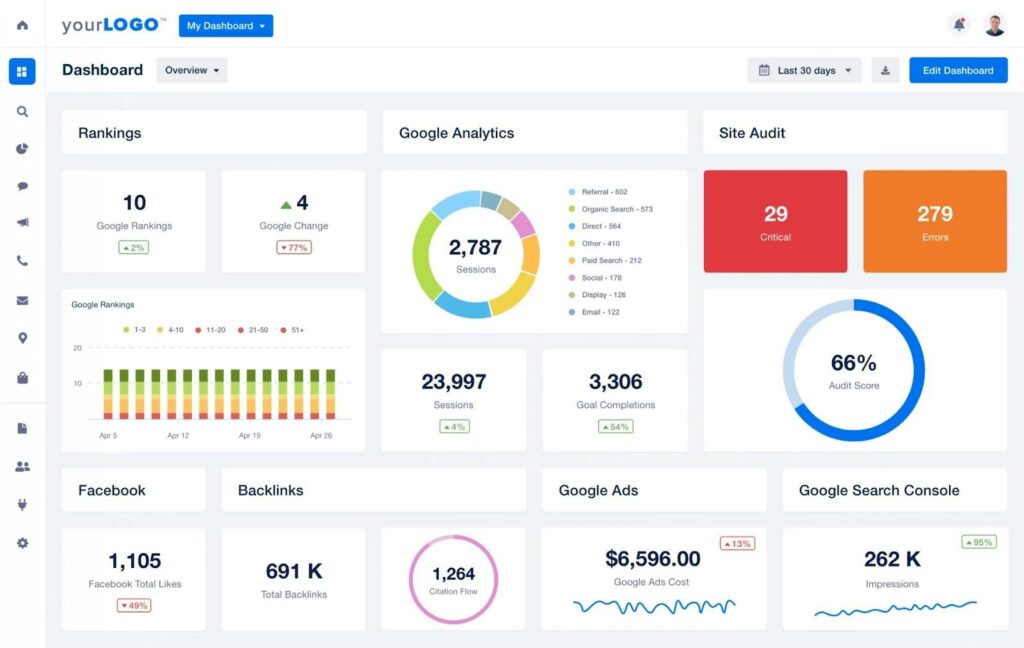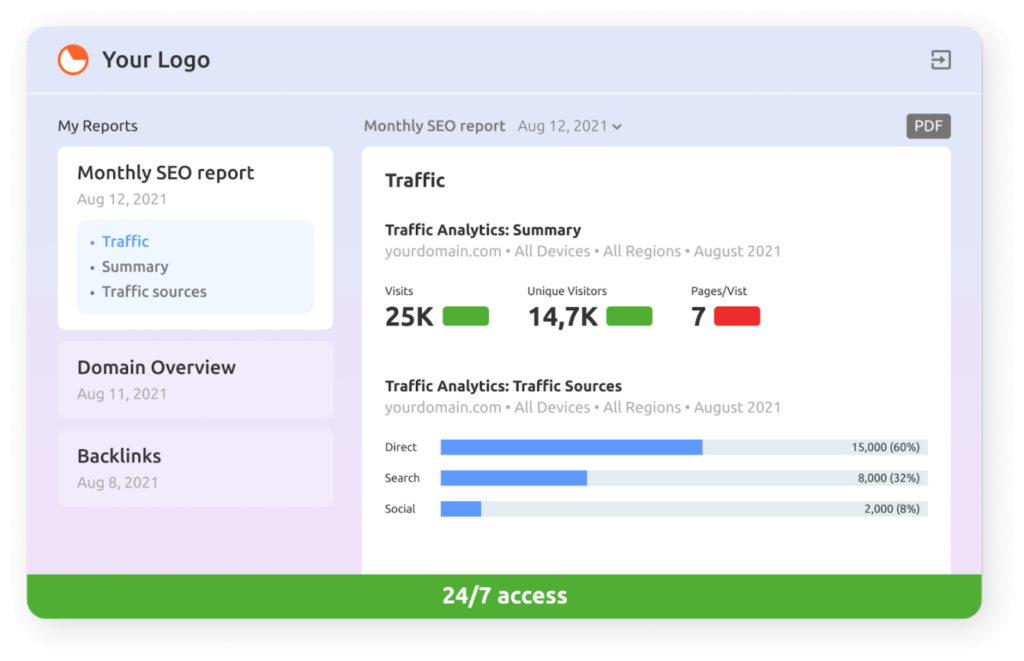Do you have a great idea but lack programming skills or the budget to hire a developer? There’s a solution called white-label software that might be able to turn your idea into a real project in just a few days.
It’s no surprise that the platform market for low-code solutions is forecasted to hit 65 billion USD by 2027.
Solutions that require (almost) no programming skills but help solve business issues are currently in high demand.
If you’re looking for such a solution, read on to find out what white-label software is, what its benefits are, and how it works.
Definition of white-label software
White-label software allows you to fully customize it, from adding your branding to setting it up on a custom domain—basically making it look like it’s your own.
It was specifically designed with the intention of helping you achieve certain goals, be that selling services, generating reports, or collecting payments, all under your own platform.
How does white labeling software work?
Like any other online software, these tools usually require you to create an account, pay a recurring fee (monthly, quarterly, annually), and make a few configurations.

Let’s assume you’re an SEO agency that wants to also offer content writing services.
You don’t have the capacity to hire writers and editors, so you’re using white-label marketplace software that allows other writers to list their content services on your website.
Everything is handled within your own P2P platform and you can charge service providers a fee, depending on your service marketplace business model.
Benefits of white-label software
There are many benefits to white-label software solutions, so let’s look at each in detail.
Time-saving
Developing software is a tedious process that takes a lot of time.
The software has to be developed, tested, and maintained. You need to ensure it works well and without any issues to provide the best possible user experience.
If you opt for a ready-made tool, you can leave the development to someone who’s been doing it for a long time.
On top of that, the developer has all the interest in making sure their solution runs as smoothly as possible.
Cost-saving
If you’ve researched software development costs, you’ve probably realized how expensive it is to create a tool tailored to your needs from scratch.
Small projects usually start at around $25,000. More than that, you need to pay the developer to maintain the software, fix issues, and make improvements.
Testing ideas
Not sure if your idea is worth exploring?
White-label software might allow you to build an MVP and test it out before you invest your money into an idea.
💡 Pro tip
You can build your MVP and have an up-and-running platform in no time. Here’s how other businesses achieved it.
Scaling up
Once you’re certain that you’ve hit the jackpot with your product or service, you’ll need to scale it up.
Easier said than done, especially with homemade software that wasn’t created to support hundreds of users.
Future-proofing
Developing and maintaining software is a costly affair that might drive you out of business.
If you opt for a third-party solution, maintenance, support, and security updates are the responsibility of the developer.
This allows you to focus your activity on the actual product development for your SaaS or selling your services.
White-label software examples to inspire you
To make it easier to understand the benefits and possibilities of white-label software, let’s look at a few concrete examples.
3veta: white-label video conferencing, scheduling, and payments
If you’re looking to keep clients on your platform, 3veta has multiple solutions for you.

In order to help you monetize your existing audience, you can:
- Implement white-label video calls into your platform
- Unify bookings, video calls, payments, and scheduling
- Build your own marketplace
- Use your favorite tools (5000+ integrations)
With its white-label software solution, 3veta is a great choice for businesses at different stages, from start-ups looking to test an idea to consultants and agencies who want to scale up their operations and marketplace owners that want to improve their value proposition. It offers a wide range of service marketplace features to make sure you are all set in no time.
Service Provider Pro: client portal for agencies
Service Provider Pro (SPP) is a popular solution for agencies and productized services looking to scale their business operations.
Many of them are struggling with deadlines and project management because they use multiple different tools, from GSuite to Trello and manual invoicing.

When client data gets lost in the abundance of information and deadlines are missed, it’s time to opt for an all-in-one solution that reduces manual work.
SPP takes care of the billing process, allows agency teams to manage orders and tasks, as well as collects project-related information via intake forms.
AgencyAnalytics: reporting dashboard for marketing agencies
AgencyAnalytics is a marketing tool that automates reporting for agencies dealing with data from different sources.
Display the number of monthly likes a Facebook page has gathered, how much the Twitter audience has grown, or how many unique visitors a website has received.

Every dashboard can be fully customized and is accessible by clients via a unique URL.
This makes reporting for marketing agencies easy because they don’t have to send reports on a regular basis; they are always available for clients.
SEMrush: for agencies who need automated reports
Marketing agencies spend many hours per week generating reports manually for their clients. SEMrush automates those tedious tasks with its reporting features—all under your own brand.
As part of its Agency Growth Toolkit, agencies can set up their own branding and send reports on a weekly or monthly basis.

For clients that don’t have a SEMrush account, the Agency Growth Toolkit also sets up a client portal.
Inside the portal, clients can access their reports as well as view and create tasks. Tasks also have an approval feature, which makes it easy to implement SEO strategies.
6 mistakes to avoid when white labeling
When it comes to white labeling, there are a few mistakes that could cause a lot of issues for your business. Let’s look at the most common pitfalls:
Choosing the wrong software
If you decide to use white-label software, make sure that it fits your business needs, is easy to set up, and scales with your operations.
Offering the wrong white-label services
Let’s assume you’re an SEO agency and one client asks if you offer social media management. Does that mean you should introduce that service?
Of course not.
One client does not create enough demand to warrant introducing that service type.
Lacking a launch strategy
You’ve settled on white-label software and service, now what? Launching without any strategy will not get you the results you’re hoping for.
You could market the new services to existing clients via a newsletter, or when you talk to them on the phone. Don’t forget to upsell leads on your new services right away—it might convince them to become a client.
Overestimating the white-label potential
Here’s the thing about white labeling—you are not selling your own service, but that of a third party.
Your profit margin will be much lower than if you’d offer the service yourself, so keep that in mind. Is it really worth it, or does it not even pay for the white-label solution you’ve chosen?
Neglecting your marketing efforts
If you’ve decided to introduce white-label SEO services as a web designer—great!
But don’t neglect the fact that you need to actively market this new service.
This goes back to the aforementioned demand. If it already exists from your clients, you can simply market it to them. If not, there’s a lot more work awaiting. And, again, is it really worth it?
Focusing on prospecting instead of retention
White labeling has a lot of potential to improve your customer retention, in theory at least.
The truth is that many businesses focus their efforts on demand generation and prospecting.
Why not upsell existing clients, though? You’ve already done the hardest part (the conversion).
And the best part, with just a 5% in retention, you could increase your profit by 25%.
Closing thoughts
Thanks to modern software solutions, it’s easier than ever to turn ideas into actual products, test them out, and launch them successfully.
Thanks to the different types of white-label software available, pretty much any business can extend its activities, launch new services, or improve existing ones.

Deian Isac
Deian is Head of Agency Success at Service Provider Pro, an all-in-one client management & billing software for agencies. SPP.co helps agencies get more clients by putting projects, accounts, and billing under one roof.
